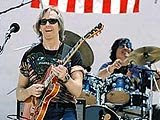Since our band, Savor, released an album of original Latin rock music after 6 years of playing as a Santana Tribute Band, it would be natural to assume that we were inspired to do so after playing Carlos Santana's music for so long. Actually, the reverse is true.
 8 years ago, I was playing in -- get this -- a 3-piece instrumental rock band. The band's goal was to create music that had hooks: actual melodic and harmonic motifs in a pop-song-like format. Talk about a challenge! It forced all of us to stretch, and as the band's main writer, I really honed my compositional skills.
8 years ago, I was playing in -- get this -- a 3-piece instrumental rock band. The band's goal was to create music that had hooks: actual melodic and harmonic motifs in a pop-song-like format. Talk about a challenge! It forced all of us to stretch, and as the band's main writer, I really honed my compositional skills.Near the end of the band's two-year tenure, I was starting to try to write songs in a Latin style. (Rather than Santana, I was inspired by Salsa and other more traditional genres of South American music.) What quickly became apparent was that having only three instruments severely limited the possibilities. I didn't really know much about Latin percussion, but something was obviously missing. So, I began to try to form a new band, with the purpose of playing Latin-flavored instrumental music.
Things didn't go so well.
For the previous project (named, ironically, "Hook"), I was lucky enough to connect with a bass player and drummer who, like me, were playing for the love of it. When trying to assemble a larger unit, however, I had trouble getting musicians to commit. One keyboard player I spoke to, though, mentioned a Santana Tribute Band he had played with previously.
 "A tribute band?" I thought. That's tacky. But the more I considered it, the more I realized it could be the method with which I had a ready-made unit available to play original songs. I decided to give it a go. The next couple of years brought two surprising (to me) results:
"A tribute band?" I thought. That's tacky. But the more I considered it, the more I realized it could be the method with which I had a ready-made unit available to play original songs. I decided to give it a go. The next couple of years brought two surprising (to me) results:1) Building a working tribute band was a lot harder than I thought!
2) I re-learned the fact that people connect with vocal songs, and began writing those as well as instrumental compositions.
Now, I will say that while Santana was not my original inspiration for my own songs, I did learn some valuable leasons while mastering his music. But that's a subject for another article.

 You launch your own private wine label, of course!
You launch your own private wine label, of course! But this legendary status now enjoyed by Carlos wouldn't exist were it not for the hits still played on radio: "
But this legendary status now enjoyed by Carlos wouldn't exist were it not for the hits still played on radio: " He must have displayed that talent early, because at 15, he had Eric Clapton and
He must have displayed that talent early, because at 15, he had Eric Clapton and  But the six years that Santana spent playing a much less known guitar -- the
But the six years that Santana spent playing a much less known guitar -- the 